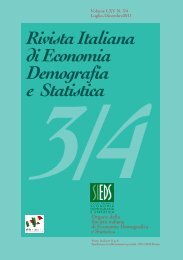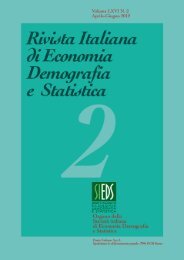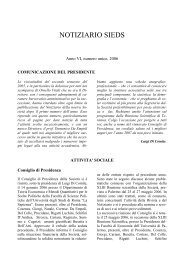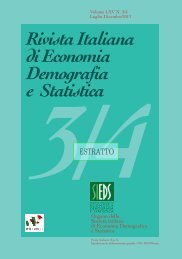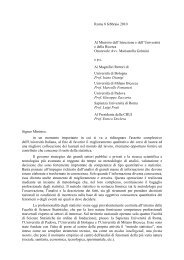rivista italiana di economia demografia e statistica - Sieds
rivista italiana di economia demografia e statistica - Sieds
rivista italiana di economia demografia e statistica - Sieds
You also want an ePaper? Increase the reach of your titles
YUMPU automatically turns print PDFs into web optimized ePapers that Google loves.
56<br />
Volume LXIII nn. 3-4 – Luglio-Dicembre 2009<br />
price than the market one, or even provided for free. IR has to be estimated only for<br />
those dwellings used as main residence by the household. There are several ways to<br />
calculate IR at a microdata level by the use of sample surveys.<br />
The capital market approach is based on an hypothetic alternative use of capital<br />
spent to own the dwelling. Operationally, it consists in estimating the current market<br />
value of the dwelling - as it were to be sold - and then applying a standard return rate to<br />
this value. The most relevant drawbacks are the determination of the value of the<br />
dwellings and the selection of the return rate; moreover, it is not applicable for<br />
households that do not own the dwellings they are living in.<br />
The rental equivalence value, also called opportunity cost method, defines and<br />
calculates IR as the opportunity cost of renting a house at the market price. By<br />
referring to the rental market instead of the capital one, this method allows the<br />
estimation of IR for all the potential beneficiaries, such as owners and free tenants or<br />
tenants paying a lower price than the market one. This approach may be implemented<br />
in <strong>di</strong>fferent ways. With the self-assessment method, owner-occupiers are asked to<br />
evaluate on their own the potential market rent of dwellings. Even if it is the easiest<br />
way to calculate IR, the main drawback consists in the subjective nature of the<br />
evaluation, that depends on the degree of knowledge of the rental market by the<br />
respondents. By using stratification method, instead, the dwellings are allocated in<br />
strata as homogenous as possible in respect of the characteristics of dwellings. The<br />
mean (or me<strong>di</strong>an) full rent paid for houses in a stratum is then considered as the IR for<br />
households with similar dwellings. Alternatively the regression method may be used.<br />
One may include information on the dwelling, as well as socio-economic<br />
characteristics of the household. Otherwise, it may be the case for an hedonic<br />
regression: accor<strong>di</strong>ng to Rosen (1974), paid rents are interpreted as equilibrium<br />
composite prices whose determination is function only of the dwelling characteristics,<br />
each evaluated in a perfect market. Regression coefficients represent the elasticities of<br />
the good prices to its characteristics.<br />
3. The model<br />
In this work we adhere to the hedonic approach. Socio-economic characteristics are<br />
taken into account to check and eventually correct for preventing biases due to a<br />
sample selection problem: this one might occur when the full market tenants are<br />
systematically <strong>di</strong>fferent from the rest of the population, both in observable or<br />
unobservable characteristics. A popular method to cope with selection bias is the<br />
Heckman (1979) two steps procedure. We apply it separately for each subpopulation.<br />
This choice should prevent from considering owners, non-market tenants and free<br />
accommodation households as a unique and homogeneous set. In other words, the three<br />
groups for which IR has to be computed may <strong>di</strong>ffer from full rent tenants as well as<br />
from each other and we want to consider all of these potential <strong>di</strong>stinctions. In our



